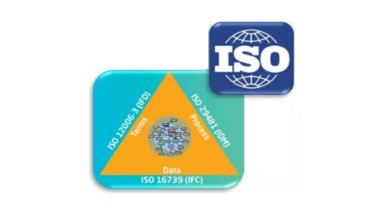Zigurat Global Institute of Technology
Blog / BIM & Construction Management
The IFC Standard: Why Now?
Categories

What is the IFC standard?
IFC stands for Industry Foundation Classes, a common standard for data exchange in the construction industry that allows information sharing regardless of the software application being used. Data used during the entire life cycle of a building remain stored and can be re-used. IFC is an object-based file format, developed by buildingSMART International, whose main objective is to facilitate interoperability within the construction sector and is used in BIM-based projects. IFC is an effective option for working with standardized file formats and is becoming a requirement for many owners and projects.
In northern Europe, countries such as Denmark have promoted its use in public construction projects. Senate Properties, a Finnish public facilities management company, also requires the use of IFC and BIM compatible software. Furthermore, the use of BIM-IFC projects is mandatory in the Norwegian government. Across the industry, many municipalities, private clients and contractors have already integrated this format into their businesses.
Uses of the IFC standard
With the use of BIM on the rise, the exchange of information is becoming a requirement, incorporated even in the so-called BIM Execution Plan or BEP. Actually, today there is a variable quality of importers and exporters of BIM tools, and most of them require custom configurations.
However, like all tools and technologies, IFC has its strengths and weaknesses. It is important to be familiar with them to know how to use IFC correctly. Today, the IFC format is used for design (visualization and shock detection) and the construction phase. During the first stage, the design team can merge or reference discipline models independently of the original application. IFC files are also used to import data from one application to another.
However, this process involves a loss of data and intelligence of the object. Having a virtual building in an open format allows contractors to make the first approach to the design and organize the schedule. Once we export, the IFC model contains not only the geometry of the building and the building data, but also all the information contained in the BIM native files. When you export the native data to an IFC file, the data can be transferred between applications. This operation is free and well documented, and allows its use by hundreds of other BIM tools and applications.
The structure of an IFC model
A model contains geometric and non-geometric data about the construction project. For example, a window is classified in the domain of the building and the system as a window. This element contains attributes and attached properties, for example, maintenance instructions, model number, size, etc. The properties have a specific structure and gather around the so-called 'set of properties'. Some of them are defined in the BEP or in the IFC standard.
However, IFC also has other ways of grouping elements, for example, those that work together such as water supply, air intake, etc. The relationships between building elements are also defined by IFC. Some of these links are used to create connections such as types, property sets, etc. The rest of them are used to describe how the building components become the building itself. Normally, connections include both the spatial structure and the way in which spaces are grouped into zones.
The future of IFC
In summary, IFC is a data model that is used to characterize both building information and geometry throughout the life cycle of the building. It has become an open ISO standard supported by the industry and promoted by a global non-profit organization, buildingSMART. Aware of the importance of working with open standards, buildingSMART International has created a Professional Certification Program.
The first part of the program ("individual qualification") aims to standardize and promote OpenBIM training. It also aims to evaluate and certify individuals. https://www.youtube.com/watch?v=Ja4L3mKYsWc The program is expected to become a milestone in the construction industry. Providing a reference for professionals that work with BIM and helping companies looking to hire BIM profiles. BuildingSMART International will not provide the training itself, but will support and accredit training organizations to provide approved courses.
This way when architects meet they can work in a common language, regardless of their origin and their working methods. Currently, the Program is being implemented in 12 countries around the world, such as Belgium, Canada, France, Germany, Ireland, Japan, Korea, Luxembourg, the Netherlands, Norway, Spain and the United Kingdom, and is expected to be included in the rest of countries that bet on BIM, in the near future. Want more information on BIM standards? Discover the evolution of European BIM Standards.



